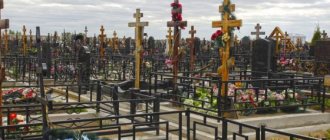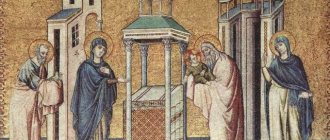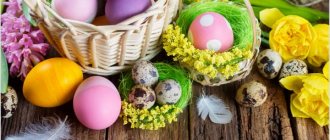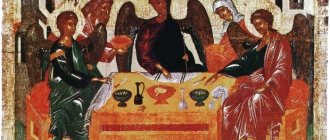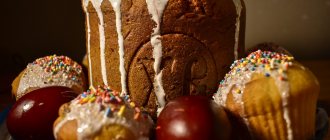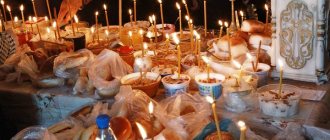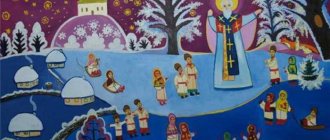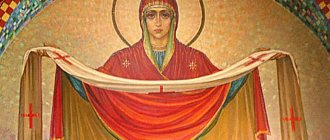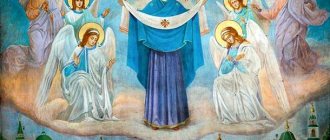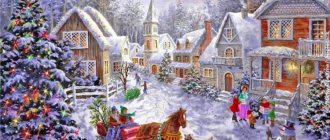Entry of the Lord into Jerusalem (Week of Vai, Palm Sunday) is the twelfth holiday, which takes place on the sixth Sunday of Great Lent and is established in remembrance of the solemn entry of the Lord into Jerusalem. This holiday is moveable, that is, its date changes every year and depends on Easter. Palm Sunday begins Holy Week - the last and most important part of Lent.
Palm Sunday. Holiday event
triumphal entry into Jerusalem was preceded by the miracle of the resurrection of Lazarus from Bethany. We find a touching account of this event in the Gospel of John. When Lazarus fell ill, his sisters Martha and Mary immediately sent to tell the Savior about this. Lazarus soon died and was buried, and only four days later the Lord came to Bethany. “Lord, if you had been here, my brother would not have died!” said Martha. The Savior replied that Lazarus would rise again, and went to the cave where he was buried. When the stone was rolled away, the Lord prayed and then cried out in a loud voice: “Lazarus, get out!” And Lazarus, entangled in burial shrouds, came out of the tomb in which he had lain for four days.
Icon "Resurrection of Lazarus". Veliky Novgorod, XV century
The Lord has raised the dead before, soon after death. But this miracle especially shocked all those present, because the smell of decay was already emanating from the deceased, he was buried and lay in the coffin for several days. Many who saw and heard about this event believed in Christ.
When the next day the Savior entered Jerusalem, where many pilgrims had gathered before the Old Testament Passover, He was greeted as a winner. The scribes and high priests, who were looking for the slightest reason to kill Jesus Christ, wanted to kill the resurrected one. Lazarus went into hiding and subsequently became the first bishop of Cyprus. He lived another 30 years.
The entry of the Lord into Jerusalem and his solemn meeting are described by all four Evangelists. The disciples, at the command of the Lord, brought to him a donkey and a colt, on which they laid their clothes, and He sat on top of them. Many people, having learned about the great miracle, met the Savior: they spread their clothes on the road, others laid cut branches. Those accompanying and greeting them loudly exclaimed:
Hosanna to the Son of David! Blessed is He who comes in the name of the Lord! Hosanna in the highest!
The donkey and the colt, which had not yet walked under saddle, symbolized the Old Testament Israel and the pagans who also believed in Christ. Evangelists point out that Jesus Christ, as the Son of David, enters Jerusalem on a young donkey, just like David after his victory over Goliath.
The people greeted Christ as a winner and triumphant, but the Lord did not go to Jerusalem for earthly power, not to free the Jews from the power of the Roman invaders. He went to suffer and die on the cross. Holy Week begins on Palm Sunday. Only a few days will pass, and many people will gather again. But this time the crowd will shout: “Crucify, crucify Him!”
Folk signs for Palm Sunday
From time immemorial, Palm Sunday has been loved by the people.
It was customary for the people to lightly hit each other with willow so that all illnesses would go away. At the same time they said: “Whip the willow, beat me to tears.” I don’t hit, the willow hits. Be as healthy as a willow.” They believed that the consecrated branches had a powerful cleansing power that could protect against damage, disease, the evil eye, predatory animals, bad people and evil spirits.
They ate 9 willow catkins, considering it a cure for infertility and fever. They put it in the water in which sick children were bathed. It was added to cattle feed and willow porridge for dinner.
Many believed that a blessed willow could stop a summer thunderstorm, and that thrown into a flame could help in a fire.
On Palm Sunday, palm markets were opened, where children's toys, books, sweets, and willow bundles with paper angels were sold. Such decorations were called palm cherubs.
There are many proverbs, sayings and signs associated with Palm Sunday:
- On the eve of Palm Sunday, Saint Lazarus was climbing a willow tree.
- Cattle are driven into the field for the first time with willow on Palm Sunday.
- It’s not spring without willow.
- If Palm Week is a busy one, with matinees, then the yari will be good.
- In the palm frost, spring bread will be good.
- The willow leads to muddy roads, drives away the last ice from the river.
- It is not the willow that strikes, but the old sin.
In Orthodoxy - The Entry of the Lord into Jerusalem . Popularly known as Palm Sunday . Whatever this holiday is called, it is of great importance to all of us. It is filled with bright joy and at the same time quiet sadness, because the very next day Holy Week will begin. And we will all remember with sorrow the Last Supper, the presentation to judgment, the crucifixion and burial of Jesus Christ.
Palm Sunday. history of the holiday
The Feast of the Entry of the Lord into Jerusalem has been known since the first centuries of Christianity. Already in the 3rd century, Saint Methodius of Patara mentioned him in his teaching. The Holy Fathers Ambrose of Milan and Epiphanius of Cyprus, who lived in the 4th century, in their sermons say that the holiday is celebrated solemnly, many believers walk on this day in a solemn procession with branches in their hands. Therefore, the holiday received another name - Vaii or Flower Week. In Rus', just at this time, fluffy earrings bloom. Hence the popular name of the holiday - Palm Sunday . On this day, food with fish is allowed. The day before, on Lazarus Saturday, it is customary to eat caviar.
Food on this day - what you can and cannot do
Palm Sunday falls during the Great Forty Days of Lent before Easter. On this holiday, the church gives a relaxation of fasting. It is forbidden to eat meat, eggs, dairy products, but you can eat fish.
Traditional holiday table treats include vegetable salads, stews with the addition of peas, beans, corn, beans, lentils, and porridge from a mixture of cereals. A popular product during fasting is mushrooms. Housewives make roasts, casseroles, pies, zrazy, soups, cabbage rolls from them. Mushrooms and legumes replace meat products. For dessert, housewives serve fruit, lean marshmallows, jam, marmalade, halva, dark chocolate, and cookies. Traditional drinks are jelly, compotes, and uzvars. On Palm Sunday you can drink a little red Cahors.
Entry of the Lord into Jerusalem. Festive service
In the stichera for the holiday, first of all, the humility of the Savior is pointed out, modestly walking on a dumb foal, and the believers are called upon to greet the Coming One with jubilant singing: “Blessed is He who comes in the name of the Lord, Hosanna in the highest.” The texts of the Orthodox service not only describe the events that took place in Jerusalem two thousand years ago, but also show us their significance, in particular, the fulfillment of Old Testament prophecies. The first proverb (Gen. XLIX, 1-2, 8-12) contains the prophecy of the patriarch Jacob to the son of Judah that kings will come from his family until the Reconciler appears (i.e. the Lord Jesus Christ); in the second proverb (Zephaniah III, 14-19) the triumph of Zion and the rejoicing of Israel are prophesied, because the Lord, the King of Israel, is among them. The third proverb (Zechariah IX, 9-15) predicts the triumphal entry of Jesus Christ into Jerusalem on a colt:
Your king is coming to you, righteous and saving; He is meek and sits on a colt and a young donkey.
The canon depicts the joy of true Israel, honored to witness the Royal Entry of the Lord into Jerusalem, and the anger of the scribes and Pharisees and high priests of the Jews with which they looked at the triumph of the Son of David. All living things are called to glorify the Lord, who goes to free and saving suffering.
Library of the Russian Faith Canon of Palm Sunday →
Read online
The evening service has a feature that distinguishes this holiday from others: after the Gospel, the priest reads a prayer over the willow tree, in which the dove that brought Noah an olive branch is remembered, and the children who met Christ with the branches with the words: “Hosanna in the highest! Blessed are those who come in the name of the Lord.” Having venerated the Gospel, the worshipers receive from the priest several branches of consecrated willow and hold them in their hands along with burning candles for the rest of the service. Returning home, believers place the willow next to the icons. It is not customary to throw away last year’s “bouquets”; they are burned or thrown into the river.
In the Apostle (Phil. IV, 4,-9) believers are called to meekness, peacefulness, a prayerful mood and fidelity to the teachings of Christ. The Gospel tells of the Lord's entry into Jerusalem (John XII: 1-18) and of the supper in Bethany.
The troparion of the holiday explains to us the spiritual meaning of the Lord’s triumphal entry into Jerusalem:
The general sunrise before your passion ўwersz, and 3з8 dead waters є3сi2 lazarz хрте b9е. the same and3 we2 ћkw џtrots, victorious џimages of the nossche, to you the conqueror of death we cry, nsanna in 8 blissful lands in 2 and 3mz.
Russian text:
Confirming the general resurrection before Your suffering, You raised Lazarus from the dead, O Christ God. That is why we, like children, wearing symbols of victory, say to You, the Conqueror of death: Hosanna in the highest! Blessed is he who walks in the name of the Lord!
Kontakion for the holiday. Church Slavonic text:
On the planet on the nb7si, on the lot on the earth2 carry1m xrte b9e, t ѓnGl praise, and3 t dеtє1st chanting of the reception, calling you, blessed є3si2 come ґdam to move.
Russian text:
Christ God, carried on the throne, and on earth on a donkey, You, received chanting from the children and praise from the Angels crying: “Blessed is the Lord, who comes to call (from hell) Adam.
Symbols and traditions of the holiday in different countries
The main symbol of Palm Sunday in Russia and other Orthodox CIS countries is the willow, or common willow. Depending on the geographical location and historical traditions of the people, the celebration may have other attributes:
- The date palm is used by Christians who live in Mediterranean countries. Palm branches were the first symbol of the holiday. They symbolized the branches with which the inhabitants of Jerusalem greeted Jesus Christ.
- Olive tree - in Switzerland and Italy. In Switzerland, this day is called Olive Sunday. In Italy, the olive is considered a symbol of peace. It is customary to give a consecrated twig to a person with whom you want to make peace.
- Coconut palm - in the Philippine Islands. Bouquets are made from its leaves, with which people solemnly glorify Jesus Christ.
- Walnut is a symbol of the holiday in Austria. On the eve of this day, residents of the country prepare thick nut shoots, which they decorate with sweets, flowers and ribbons.
- Dried flowers - in Poland and Lithuania. In these countries, on Palm Sunday, bouquets of dried cereal shoots, ears of wheat, juniper and blue paper flowers appear.
- Tees - in England.
- Orange - in France. Long before Palm Sunday, the French sprout an orange seed in a flower pot. On the eve of the holiday, they decorate young sprouted shoots with ribbons and take them with them to worship.
"Procession on a Donkey"
In the XVI–XVII centuries. in Rus' in Moscow, Veliky Novgorod and other large cities there was a custom to perform a religious procession on the day of the holiday in a special way. In Moscow, a solemn procession of the cross went from the Assumption Cathedral of the Kremlin to the Cathedral of the Intercession on the Moat (St. Basil's Cathedral), one of the chapels of which was consecrated in the name of the Lord's entry into Jerusalem. The Patriarch rode on a young donkey, which was led by the king. Most often, the “donkey” was symbolic - a horse of a light color.
The western aisle of St. Basil's Cathedral (Pokrovsky Cathedral on Red Square) was consecrated in the name of the Lord's entry into Jerusalem
In Rus', this custom did not arise independently, but was borrowed from the Greeks. In the Church of Constantinople, the “procession on a donkey” was known back in the 9th–10th centuries. The earliest Russian evidence of such a custom is in the expense books of the St. Sophia Cathedral of Veliky Novgorod for 1548. The Novgorod governor drove a donkey on which the archbishop sat. The procession went from St. Sophia Cathedral to the Church of the Entrance to Jerusalem and back. It is known that such a ceremony was also held in the 17th century in Rostov the Great, Ryazan, Kazan, Astrakhan and Tobolsk. At the end of the 17th century, the custom was abolished.
Celebrating Palm Sunday on Red Square. Engraving from the book by A. Olearius “Description of a Journey to Muscovy...”. Mid-1630s - first half of the 1640s.
Signs and beliefs
- If the weather is good on Palm Sunday, there will be a good harvest of fruit.
- In order for there to be prosperity and prosperity in the house, on this day it is necessary to plant or replant an indoor flower. If it grows well, then you should expect profit, and if it withers, prepare for losses.
- If a girl wants to get married in the next year, then she needs to break branches on a young willow before dawn, put them at the head of the bed and think about her loved one all day.
- Before committing an important task, you need to eat three willow buds stored on Palm Sunday. They can attract good luck.
- To get rid of a headache, you should comb your hair thoroughly, collect the hair from the comb, dip it in water and pour it at the roots of the willow.
Palm Sunday in folk traditions
Some folk rituals and customs were dedicated to Palm Sunday. During Matins, the peasants prayed with blessed willow and, upon coming home, swallowed willow buds in order to protect themselves from illness and drive away any illness. On the same day, women baked nuts from dough and gave them to all household members, including animals, for health. The consecrated willow was preserved until the first pasture of livestock (April 23), and every pious housewife drove the cattle out of the yard with the willow, and then the willow itself was either “put into the water” or stuck under the roof of the house. This was done with the aim that the cattle would not only be preserved intact, but also return home in good order, and would not wander in the forest for several days.
Russian historian and ethnographer of the second half of the 19th century M. Zabylin in the book “Russian People. Its customs, rituals, legends, superstitions and poetry” describes the traditions of Palm Week.
“Palm week, or Vai week, is enlivened for us purely by the holiday of the beginning of spring; a willow or willow, which has not yet given leaves, blooms and thus, as it were, declares that our northern nature will soon reward us and everything living on earth with new blessings. The holiday itself, the Resurrection of Lazarus, serves as a symbol of the renewal and revitalization of powerful nature. During Palm Week, children's bazaars have been established in the capitals, where they sell mainly children's toys, willows, flowers and sweets, as if to commemorate the fact that small children have met the spring of their lives and should rejoice in this life, and looking at the toy, study the essence of it. of his future, since each toy is a visual literacy, a visual teaching that develops further understanding in the child, bringing him closer to life and developing his thinking through visualization, comparison of actions and images. On Lazarus Saturday, everyone is allowed to eat caviar, Lenten pancakes and various kitchen cookies.
On Palm Sunday, returning from church with blessed willow twigs, the village women whip their children with them, saying: “Whip the willow, beat them to tears!” In Nerekhta, peasant women bake lambs on Palm Sunday, and when they come from church, they feed the cattle with these lambs, and stick willows in the village at St. icons and take care of it all year round until St. George's Day. This custom is preserved in many provinces. It is known that in our country the first spring pasture of livestock begins on St. George's Day. On this day, the peasants take a one-year-old willow, soak it in holy water, sprinkle it on the cattle in the yard, and then whip the cattle with this willow, saying: “Lord, bless and reward with health!” And sometimes they simply say: “Bless you, Lord, and be healthy”... and with a willow in their hands they take you to a place of pasture. The consecrated willow is highly respected and is usually preserved by the Russian pious people behind images for a whole year. In some provinces, willow, blessed on Palm Sunday, is used as a sympathetic remedy and placed in the swill of sick cows or calves.”
Properties of the blessed willow
A consecrated willow becomes a shrine. She has miraculous powers throughout the year. The church recommends keeping it in the house near the icons until next Palm Sunday. This helps to attract health, prosperity, and good luck.
You cannot throw twigs in the trash. This can lead to illness and money problems. Used or worn out willow can be:
- let the river flow;
- burn separately from garbage;
- bury in a clean place;
- put between the bushes of growing young willow;
- use to expel evil spirits and cleanse the house - set fire to a twig and walk around all corners of the room with it;
- give it to the nearest temple, where they will burn the willow with prayer.
Entry of the Lord into Jerusalem. Icons
Images of the Savior riding on a donkey are already known in early Christian art.
Entry of the Lord into Jerusalem, fragment of a fresco. Vysoki Decani Monastery, Serbia, XIV century
Almost all images of the Entry of the Lord into Jerusalem have a common compositional scheme, but differ significantly in details. Christ, blessing with his right hand, sits on a donkey, He is accompanied by two apostles talking with each other. One of them, according to a stable iconographic type, is identified as Peter, while the second apostle, quite young, may be Thomas, Philip or John. At the bottom of the compositions children are depicted rejoicing at the coming of the Savior. An indispensable element of the holiday’s iconography is the image of the Mount of Olives.
Entry of the Lord into Jerusalem. First half of the 16th century Museum named after Andrey Rublev
A significant change in the iconography of the Entry of the Lord into Jerusalem occurs in the 14th - early 15th centuries. Now the Savior is most often presented in a complex perspective - turning back to the apostles. The pose of Christ in question is present on icons from the festive row of the iconostasis of the Annunciation Cathedral of the Moscow Kremlin, the Assumption Cathedral of the Kirillo-Belozersky Monastery, tablet icons from Novgorod and many others.
Entry of the Lord into Jerusalem. State Tretyakov Gallery, Moscow, XVI century.
Entry of the Lord into Jerusalem. State Tretyakov Gallery, Moscow. Mid-15th century
In Pskov images of the 16th century, the Savior is represented sitting feet first, and his left shoulder is turned towards the viewer so that He enters Jerusalem almost with his back forward.
Entry of the Lord into Jerusalem. Pskov State United Historical, Architectural and Art Museum-Reserve. First half of the 16th century
Temples in honor of the Entry of the Lord into Jerusalem
In many ancient cities, churches in honor of the Entry of the Lord into Jerusalem were built in the 14th–15th centuries. To this day, they have survived mainly in a reconstructed form. Thus, the temple in Veliky Novgorod, built in 1336 by Bishop Vasily, was dismantled “due to disrepair” in 1759. At the same time, construction began on a new cathedral designed by the architect Rastrelli. The building has survived to this day and houses a lecture hall.
The building of the temple in honor of the Entry of the Lord into Jerusalem in Veliky Novgorod
Often the temple was not independent, but was considered a chapel of the main city cathedral, even if it stood separately. Perhaps this is connected with the rite of “procession on a donkey”? With the time of the emergence and spread of this custom in Rus', the construction of churches in honor of the Entry of the Lord into Jerusalem or chapels in Moscow (the western chapel of St. Basil's Cathedral), Ryazan, Kashin, Kazan, Suzdal and other cities coincides.
The rector of the Yuryevets Povolzhsky Cathedral (now Ivanovo region) was Archpriest Avvakum. True, he served there for a short time, only eight weeks. The new archpriest was so strict with his flock, trying to correct people who were accustomed to a dissolute life, that they beat him almost to death! The governor posted guards around the house and did not allow the massacre to be completed. The rebellion did not subside, and Archpriest Avvakum was forced to flee to Kostroma, and then to Moscow, where he later served in the Kazan Cathedral on Red Square. And the cathedral in honor of the Entry of the Lord into Jerusalem in Yuryevets was rebuilt in the 18th century and has survived to this day.
Next to the bell tower there is a five-domed cathedral in the name of the Entry of the Lord into Jerusalem (rebuilt at the end of the 18th century). Archpriest Avvakum was its rector for a short time. Yuryevets Povolzhsky. Photo by S. M. Prokudin-Gorsky, 1910
In honor of the Entry of the Lord into Jerusalem, the chapel of the Assumption Cathedral in the city of Belozersk, Vologda Region, . The church was built by 1553. The architects and builders of the cathedral were Goryain Grigoriev Tsarev and Tretyak Borisovich Rostovka. The Assumption Cathedral of the Kirillo-Belozersky Monastery was chosen as a model for the construction of the Assumption Church. A legend has been preserved that in 1613 the Assumption Church was destroyed and desecrated by the Poles, who kept horses in it and lit a fire.
Assumption Cathedral in Belozersk, Vologda region
In honor of the Entry of the Lord into Jerusalem, the chapel of the Annunciation Cathedral of the Moscow Kremlin . At the turn of the 13th-14th centuries, on the site of the existing cathedral, a wooden Annunciation Church stood on a stone foundation. At the end of the 14th century, a small white stone temple with a basement was erected instead. In 1484 the old one was dismantled and rebuilt. Construction of the new cathedral continued until August 1489. The Pskov architects who built it managed to give the temple an impressive appearance, perfectly combined with exquisite decorativeness. In 1563-1564, by order of Ivan Vasilyevich the Terrible (1530-1584), the Annunciation Cathedral was rebuilt.
Annunciation Cathedral of the Moscow Kremlin
In honor of the Entry of the Lord into Jerusalem, the chapel of the Church of the Intercession on the Moat in Moscow . The Intercession Cathedral is located on Red Square, near the Spassky Gate and Lobnoye Mesto. Initially, a stone church of the Holy Trinity was built here, called “Trinity on the Moat,” because across the entire square along the Kremlin wall there was a deep and wide moat, filled up only in 1813. St. Basil, the Fool for Christ’s sake, was buried near this stone church . On October 1, 1554, by order of Ivan the Terrible, a wooden Church of the Intercession with seven chapels was consecrated in honor of the Kazan victory. It stood for less than a year and was dismantled, and a stone cathedral was laid in its place. Construction of the temple began in 1555. Its main part was erected by the autumn of 1559. A year and a half later, on June 29, 1561, the entire cathedral was consecrated, and this day became the date of completion of the temple. The exact date of completion of the construction of the Intercession Cathedral became known when restorers in 1957-1961 revealed the text of the temple “chronicle”, made in a circle at the transitions from the octagon to the tent and on the edges of the tent of the Intercession Church: “By the grace of God and the Most Holy Theotokos by the mercy and prayers of all saints By the command of the pious Tsar Grand Duke Ivan Vasilyevich of All Rus', the autocrat and under his noble children under Tsarevich Ivan and under Tsarevich Theodore, with the blessing of Macarius, Metropolitan of All Rus', this holy Church of the Intercession of the Most Holy Theotokos was completed in the summer of 7069, June 29, in memory of the saints and all-validated Supreme Apostles Peter and Paul in honor and glory of the Holy Trinity." This gives the date June 29, 1561, when the church was completed. In 1588, the tenth St. Basil's Church was added to it. At the end of the 16th century, figurative domes of the cathedral appeared - instead of the original covering, which burned down during another fire. Subsequently, the cathedral was rebuilt several times. In the second half of the XVI-XVII centuries. The Intercession Cathedral was the semantic center of the celebration of the Entry of the Lord into Jerusalem: a solemn church procession led by the Tsar and the Patriarch, called the “procession on a donkey,” headed to it from the Assumption Cathedral of the Kremlin. For four and a half centuries, the Intercession Cathedral witnessed all the significant events of Russian history: coronation processions and solemn religious processions took place next to it, state decrees were announced and petitions were drawn up, city life was in full swing around it.
Cathedral of the Intercession on the Moat in Moscow
There are no Old Believer churches consecrated in honor of this holiday.
